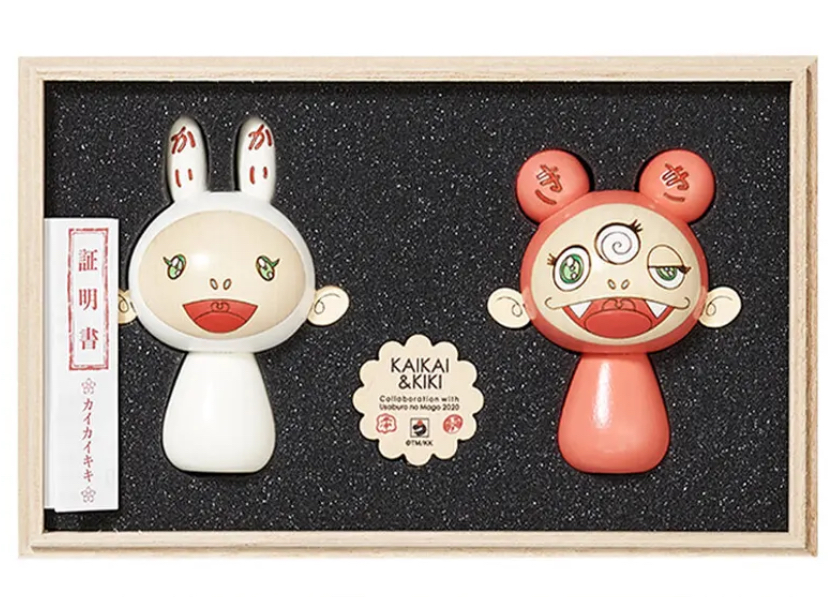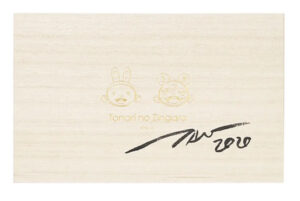Among the many works Takashi Murakami has produced in his astonishingly prolific career, Mago (2020) stands apart — not simply for its aesthetic execution, but for the profound emotional terrain it quietly navigates. Created in Japan during a period marked by both global uncertainty and intense personal reflection, Mago emerges as a nuanced, multilayered meditation on heritage, evolution, and the fragile continuity of cultural memory.
Murakami, long celebrated (and occasionally critiqued) for his dazzling fusion of pop sensibility and classical Japanese techniques, delivers with Mago something different: a work that retains his signature vibrancy but hums with a new kind of gravity. It is a painting that, while retaining the artist’s unmistakable visual language, moves beyond the surface pleasures of color and character to engage with questions of lineage, survival, and what it means to create in the aftermath of crisis.
Context: Murakami’s World in 2020
By the time Murakami created Mago, he had long transcended the traditional confines of the fine art world. From his early Superflat manifesto — which theorized a postmodern collapse of high and low cultural hierarchies — to his collaborations with Louis Vuitton, Kanye West, and Virgil Abloh, Murakami had established himself as a global force.
But 2020 was different. It was the year when the COVID-19 pandemic ground the world to a halt, when the previously frenetic rhythms of contemporary art commerce were disrupted. Galleries closed. Fairs were canceled. Public spaces fell silent. For an artist like Murakami, whose work thrived on circulation, spectacle, and immediacy, this forced stillness presented a profound challenge — and a profound opportunity.
It is within this crucible that Mago was born: not as a commercial spectacle, but as a deeply personal reflection on time, continuity, and impermanence.
Title and Thematic Resonance: What Mago Means
The title Mago (孫) is the Japanese word for “grandchild.” It immediately signals that this is a work concerned with generational transmission — not just literal ancestry, but the broader questions of what is passed down, what endures, and what mutates across time.
In Japanese culture, the figure of the grandchild occupies a symbolic space of hope and future continuity. Grandchildren represent not just personal lineage but the survival of values, traditions, and dreams through an uncertain future. By naming the piece Mago, Murakami positions the artwork as both an offering and a question: what do we leave behind? And what, if anything, carries forward after us?
In a year when mortality was thrust brutally into public consciousness, Mago resonates as an act of creative defiance — a reminder that even in the face of global rupture, the act of making, of imagining, of transmitting meaning, persists.
Visual Analysis: Composition, Color, and Form
At first glance, Mago feels immediately familiar to anyone versed in Murakami’s universe. The vivid, candy-like colors; the thick black outlines; the almost compulsive repetition of motifs — all hallmarks of his Superflat aesthetic — are present.
But look closer, and the tonal shift becomes apparent.
Compositionally, Mago centers around a singular, childlike figure rendered with enormous eyes, a rounded body, and an expression that oscillates between wonder and melancholy. Unlike Murakami’s riotous fields of flowers or his chaotic dreamscapes filled with Mr. DOB variations, Mago isolates its subject, giving it space to breathe — and to confront the viewer.
The palette is notably restrained by Murakami standards. While there are bursts of saturated hues — hot pinks, electric blues, acidic yellows — they are balanced by cooler, softer tones: misty grays, faded purples, melancholic greens. The effect is one of dynamic tension, a visual oscillation between joy and sadness.
Formally, the surface of Mago retains the glossy perfection associated with Murakami’s practice. Layers of acrylic and silkscreen create a slick, almost plastic finish, invoking both the seductions of consumer culture and the alienating distances of technological mediation. Yet within that polish, there is a noticeable fragility. Small cracks, disruptions in the linework, moments where the figure seems on the verge of dissolving — these hint at an underlying vulnerability that Murakami rarely foregrounds so directly.
In Mago, the perfection of technique becomes a foil for the imperfection of existence. It is a painting that dares to wear its contradictions openly.
Cultural References: Between Edo and Instagram
Murakami’s genius has always been his ability to synthesize vast cultural references into a seamless, visually immediate language. Mago is no exception.
On one level, the work draws from Edo-period Japanese painting, particularly the ukiyo-e tradition — the “pictures of the floating world” that captured the transient beauty of urban life, nature, and the ephemeral pleasures of existence. The clean lines, flat planes of color, and emphasis on emotional immediacy in Mago all echo this historical lineage.
At the same time, Mago is unmistakably a product of the digital age. Its hyper-saturated palette, meme-like figure, and photogenic composition are perfectly attuned to the logic of Instagram, TikTok, and the endless circulation of images across screens.
Murakami collapses these temporalities: ancient and futuristic, analog and digital, memory and immediacy. Mago becomes a bridge across these worlds, insisting that tradition and innovation are not opposing forces but intertwined currents.
Emotional Resonance: The Child and the Crisis
At the heart of Mago lies a profound emotional charge. The childlike figure — at once endearing and unsettling — serves as an avatar for vulnerability in an unstable world.
Unlike the ironic detachment that characterizes much of Murakami’s earlier work, Mago feels genuinely tender. There is sadness here, but also resilience. The wide, unblinking eyes seem to ask: what now? What future will unfold from this fractured present? How do we protect what is fragile, and how do we learn to move forward when the ground beneath us keeps shifting?
In this sense, Mago is less about nostalgia for a lost past than it is about the radical, difficult hope that something — some part of us — will survive. That creativity, memory, love, and curiosity will outlast the storms of history.
This is what makes Mago one of Murakami’s most human works. It acknowledges despair without succumbing to it. It chooses, against all odds, to believe in continuation.
Murakami’s Personal Reflections: Beyond the Studio
It is important to note that 2020 was not just a challenging year for the world, but for Murakami personally. Financial pressures, studio restructuring, and public scrutiny forced the artist into a period of reevaluation.
In interviews, Murakami has spoken candidly about considering bankruptcy, about questioning the meaning of his career, about grappling with the collapse of structures he once trusted. Mago can be read as a direct emotional response to these pressures: a work that strips away bombast to focus on what remains when everything else falls away.
In choosing to paint Mago — a single, vulnerable, hopeful figure — Murakami stakes his future not on market dominance, but on emotional truth. It is a risky, brave, and profoundly moving gesture.
Flow
In its brilliant collision of historical reference and digital immediacy, in its emotional clarity and technical mastery, Mago reminds us why Murakami remains one of the most vital artists of our time. Not because he is trendy. Not because he is marketable. But because he understands that art — at its deepest level — is an act of memory, of persistence, of hope.
No comments yet.









